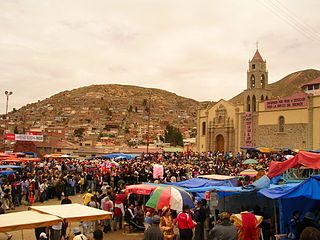
Boutilimit lies 164 km south east of Mauritania's capital of Nouakchott. The town has been an important center of religious scholarship and training since its founding by an Islamic mystic and scholar in the 19th Century. Although desertification has sapped much of the community's economic energy, it remains the most important center of religious training in Mauritania. Its Qur'anic school is known for its library of manuscripts, set up by Shaykh Sidiyya "al-Kabir" (1774–1868), which is second only to the collection found in the ancient Mauritanian city of Chinguetti. A unique copy of a grammar by Averroes was recently found there.
Golmayo is municipality in Spain, located in the province of Soria, in the autonomous community of Castile-Leon, Spain. The town lies at an altitude of 1,025 mt. The municipality covers an area of 190 km².

Aagaard Glacier, also known as Glaciar Alderete, is an 8-mile (13 km) long Antarctic glacier which lies close to the east of Gould Glacier and flows in a southerly direction into Mill Inlet, on the east coast of Graham Land. It was charted by the Falkland Islands Dependencies Survey (FIDS) and photographed from the air by the Ronne Antarctic Research Expedition during December 1947; it was named by the FIDS for Bjarne Aagaard, a Norwegian authority on Antarctic whaling and exploration.

Salinas de Garci Mendoza is a town in the Bolivian Oruro Department. It is the administrative center of Ladislao Cabrera Province and is located 280 km (170 mi) south-west of Oruro, the capital of the department. It is situated at an elevation of 3,732 m (12,244 ft) at Caricha, 20 km north of the Tunupa stratovolcano. Salar de Coipasa,a salt lake, is 20 km north-west of Salinas de Garci Mendoza, and 15 km in south-eastern direction is Salar de Uyuni, the world's largest salt pan. Salinas de Garci Mendoza is the endpoint of the road from Chuquichamba via Andamarca and Aroma to Salinas de Garci Mendoza.

Chałupy is a village and a Polish sea side resort with good conditions for windsurfing and kitesurfing, in Gmina Władysławowo. It is located between Władysławowo and Kuźnica on the Hel Peninsula on the southern Baltic Sea in Puck County, Pomeranian Voivodeship, northern Poland. It has 376 inhabitants (2009).
Villadangos del Páramo is a municipality located in the province of León, Castile and León, Spain. According to the 2004 census (INE), the municipality has a population of 1,018 inhabitants.
Villaluenga de la Vega is a municipality located in the province of Palencia, Castile and León, Spain. According to the 2004 census (INE), the municipality has a population of 667 inhabitants.

Huérmeces is a municipality located in the province of Burgos, Castile and León, Spain. According to the 2004 census (INE), the municipality has a population of 131 inhabitants.
Aldehorno is a municipality located in the province of Segovia, Castile and León, Spain. According to the 2004 census (INE), the municipality has a population of 62 inhabitants.
Santa Cruz de Andamarca District is one of twelve districts of the province Huaral in Peru.

Ouarakuy is a village in the Sanaba Department of Banwa Province in western Burkina Faso. As of 2005 it had a population of 549.
Tomena is a village in the Iolonioro Department of Bougouriba Province in south-western Burkina Faso. The village has a population of 503.

El Pardo is a ward (barrio) of Madrid belonging to the district of Fuencarral-El Pardo. As of 2008 its population was of 3,656.
Tehuipango is a municipality located in the montane central zone in the State of Veracruz, about 110 km from state capital Xalapa. It has a surface of 111.04 km2. It is located at 18°31′N97°03′W. Santiago Tehuipango, it was a people belonging to Zongolica's federation, during the 16th century, later it tried to form its own town hall; in 1831 a municipality was consisting already of basics schools and parish of masonry. It was bordering on Mixtla, Eloxitlan, Alcomunga, Astacinga and Texhuacán.

Armstrong Glacier is a glacier flowing from the south side of Mount Bagshawe westward into George VI Sound. It provides the only known safe route for mechanical vehicles from George VI Sound to the Palmer Land plateau. It was named by the United Kingdom Antarctic Place-Names Committee for Edward B. Armstrong, British Antarctic Survey surveyor at Stonington Island, 1964–65.

Swithinbank Glacier is a glacier on the west side of Hemimont Plateau flowing north to the southeast corner of Square Bay, in Graham Land. Mapped by Falkland Islands Dependencies Survey (FIDS) from surveys and air photos, 1946-59. Named by United Kingdom Antarctic Place-Names Committee (UK-APC) for Charles Swithinbank, British glaciologist, a participant in several British, New Zealand and American expeditions to Antarctica, 1949-62.
Lliboutry Glacier is a glacier flowing southwest from the Boyle Mountains of Antarctica into Bourgeois Fjord, Loubet Coast. It was named by the UK Antarctic Place-Names Committee in 1983 after Louis A.F. Lliboutry, a French physicist and glaciologist who investigated the mechanical deformation of ice and the micro-meteorological properties of ice surfaces, and who also made a general study of glaciers in the Antarctic Peninsula. Lliboutry was Director of the Laboratory of Glaciology, University of Grenoble, 1958–83, and President of the International Commission on Snow and Ice, 1983–87.
Soto Glacier is a glacier about 12 nautical miles (22 km) long, draining southeast along the southwest side of Strømme Ridge and discharging into Odom Inlet, on the east coast of Palmer Land. Mapped by United States Geological Survey (USGS) in 1974. Named by Advisory Committee on Antarctic Names (US-ACAN) for Luis R. Soto, Argentine oceanographer on the International Weddell Sea Oceanographic Expeditions, 1968 and 1970.

Isallavi is a village in the Bolivian Oruro Department. It is the birthplace of Evo Morales, Bolivia's President.















